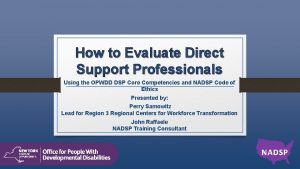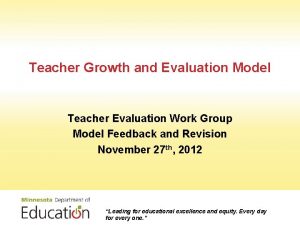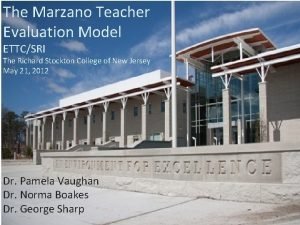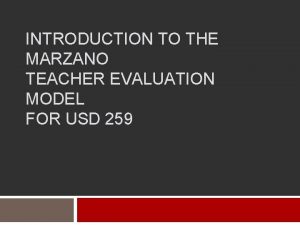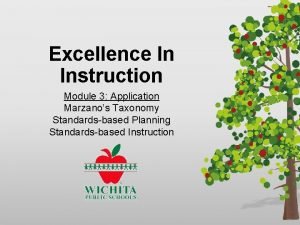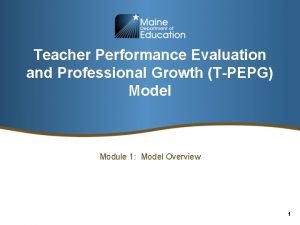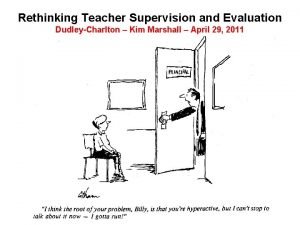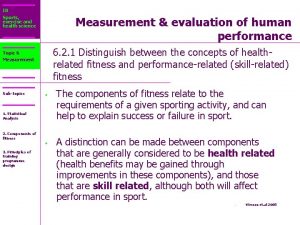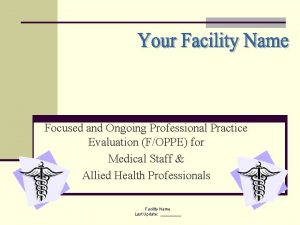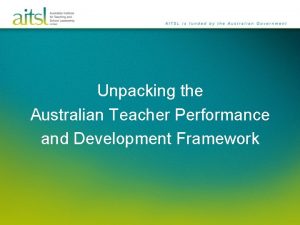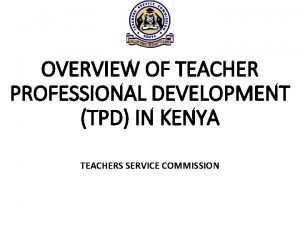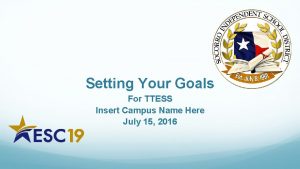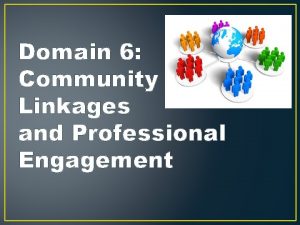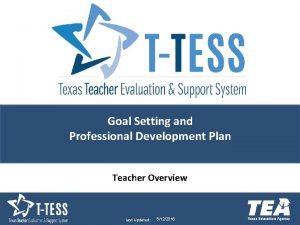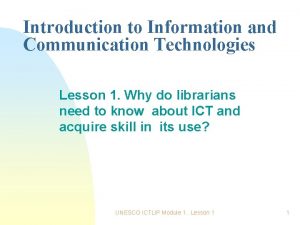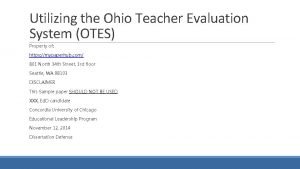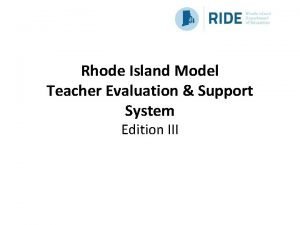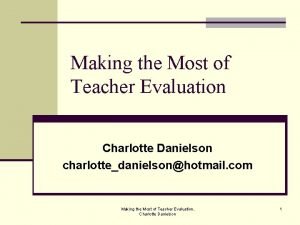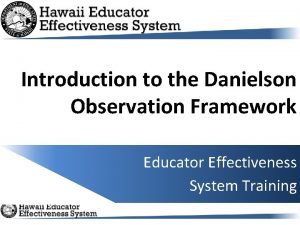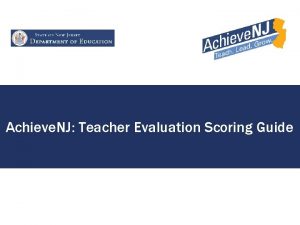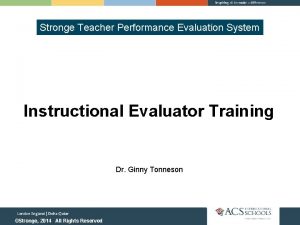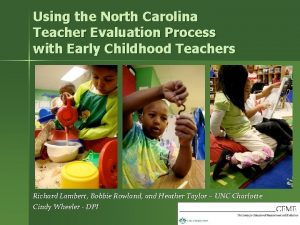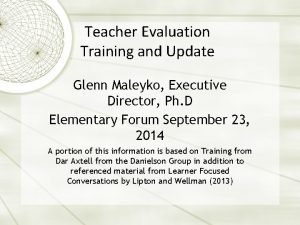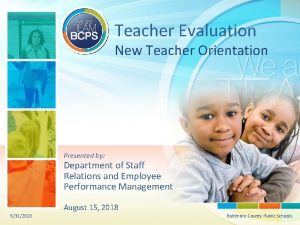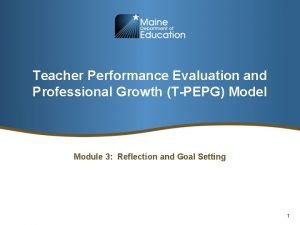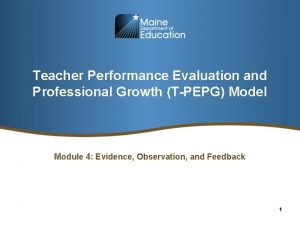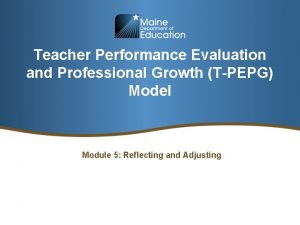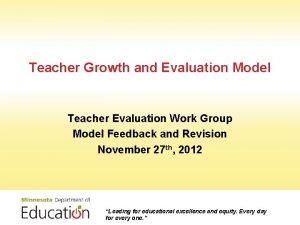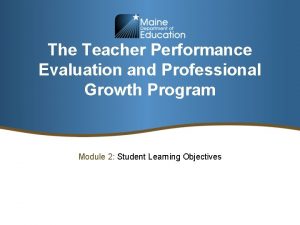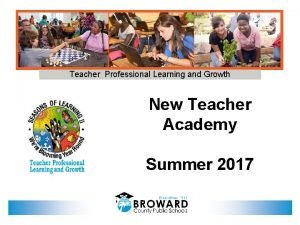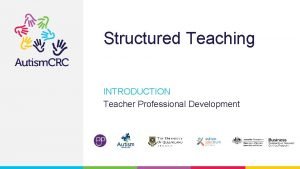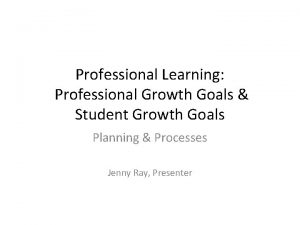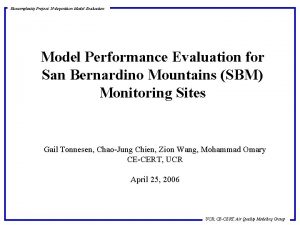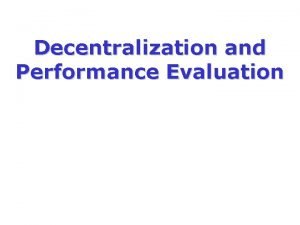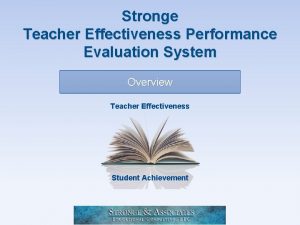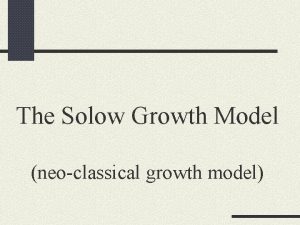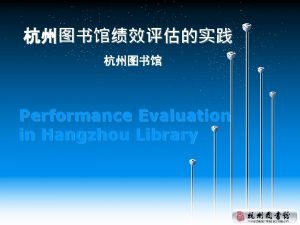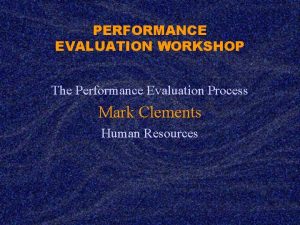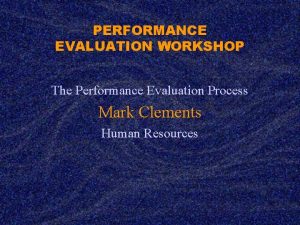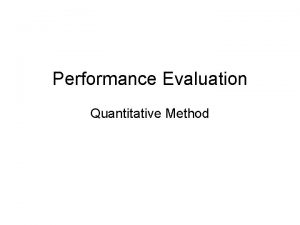Teacher Performance Evaluation and Professional Growth TPEPG Model









































- Slides: 41

Teacher Performance Evaluation and Professional Growth (T-PEPG) Model Module 4: Evidence, Observation, and Feedback 1

Module 4: Model Overview • • Module 1: Model Overview Module 2: Student Learning Objectives Module 3: Reflection and Goal Setting Module 4: Evidence, Observation, and Feedback – The fourth module describes expectations for observations; the collection and organization of observation evidence; and the sharing of timely, constructive feedback. Participants engage in peer observation and learn strategies to make the process meaningful, collaborative, and constructive. • Module 5: Reflecting and Adjusting 2

Agenda • Welcome (5 minutes) • Connecting (20 minutes) – Problem Pose/Problem Solve Protocol • Learning (1 hour, 35 minutes) – Pre-observation, Evidence Collection, and Postobservation • Implementing (1 hour, 20 minutes) – Conducting a Practice Observation – Role Playing: Giving Feedback to a Peer • Reflecting (15 minutes) – Planning Your Peer Observation, Preparing for Module 5 3

Intended Outcomes • At the end of this session, participants will be able to – Understand the Points of Contact Framework – – – documentation Identify types of teacher-collected evidence Distinguish between high- and low-quality evidence Understand the observation process Give feedback to peers using observation evidence Explain their role in peer observation 4

Connecting 20 MINUTES 5

Connecting Activity: Problem Pose/Problem Solve • Share a challenge with colleagues, who will take turns brainstorming solutions. • Choose a challenge related to your implementation of SMART goals or SLOs. 6

Connecting Activity: Problem Pose/Problem Solve • Directions: – Step 1. Form groups of three and take out Handout 1. – Step 2. Write a challenge in the middle box; in the top left corner, share what you tried in order to conquer the challenge. – Step 3. Pass your paper to the left to colleague 1, who will write suggested solutions for this problem in the top right box. – Step 4. Pass the paper again to the left to colleague 2, who will write more suggested solutions in the lower left corner. – Step 5. Pass the paper back to the original author, who will put a star next to ideas he or she plans to try out and write any other thoughts in the last box. 7

Connecting Debrief • What challenge did you share? • What solutions did your colleagues present? 8

Learning: Evidence Collection 1 HOUR, 35 MINUTES 9

The Four-Step Evaluation Process Step 1: Expectations and Goal Setting Fall Step 4: Professional Growth Plans Spring-Fall-Spring Step 2: Evidence, Feedback, and Growth Late Winter-Spring Step 3: Reflection and Rating 10

Core Propositions and Standard Indicators • Core Proposition 4: Teachers think systematically about their practices and learn from experience. – 4. 2—Continuous Professional Growth: The teacher uses current research-based resources, ongoing feedback from others, and professional learning opportunities to accomplish professional growth. • Core Proposition 5: Teachers are members of learning communities. – 5. 1—Professional Collaboration: The teacher contributes to school effectiveness by collaborating with other professionals on activities that support school improvement and student learning. 11

Reminder: Points of Contact Framework Point of Contact Menu Formal Observation Extended Classroom Observation Series of Informal Classroom Observations • Person to person • Documented • Evidence based Video Lesson Review Curriculum Review Student Engagement Analysis Review of Student Learning Data Professionalism Observation/Conference Other 12

Points of Contact Requirements • Prior to your first summative rating and assignment to a growth plan, you must complete six minimum Points of Contact (POCs), distributed as follows: Teacherselected • 1 Peer POC • 1 Evaluator POC Required • 1 Peer Observation • 1 Formal Observation Evaluatorselected • 2 POCs 13

Selecting Points of Contact: Guidance • Professional growth goals: Which points of contact will provide me with the feedback I need to ensure I will meet my professional goals? • Student needs: Which points of contact will provide me with the feedback I need to help ensure my students meet their learning goals? • Evidence: Which points of contact will help me provide strong evidence of my practice on each of the Core Propositions and indicators in the MSFE Rubric? 14

Turn and Talk: Ms. Jones’s Points of Contact SLO Focus Professional Goals • Content: Geometry and Geometric Measurement • Instructional plan: – Questioning for higher- 1. Lead grade-level team effort to create 3 new formative assessments for CCSS geometry content order thinking, – Developing problembased task or assessment 2. Develop and refine 3 new project-based tasks with real-world connection 15

Observation in the T-PEPG Model Professionalism Observation or Conference Formal Classroom Extended Classroom Series of Informal Classroom Student Engagement Analysis (observation that tracks student engagement or other response) 16

Observations: An Overview Evaluator Peer Announced or Unannounced Always Announced Varies by type of observation To discuss evidence, ratings, and feedback on strengths and areas for improvement To discuss targeted evidence and to collaboratively discuss feedback on strengths and areas for improvement Ratings and feedback are discussed; evidence is included in summative evaluation Feedback is discussed. Evidence is NOT included in summative evaluation Type Length Purpose Outcome 17

Appendixes G and H: Pre-observation Protocol Purpose • The pre-observation is an opportunity to discuss the observation process and for a teacher to share evidence of lesson and unit planning and how student data are used to inform lesson design. 1. Review a sample with a partner 2. Discuss: • • • What additional questions do you have about this lesson after reading this form? If you were the teacher, what other information would you include if you were writing responses to these questions? What can teachers do to make sure they set these conversations up for success? 18

Collecting Observational Evidence 19

Types of Evidence Verbatim: Teacher: Group 5, please get started on your assignment. Numeric: 23 out of 30 students were reading silently. Factual summaries: Ms. T stood by the door to greet students. Observed: Classroom rules were posted. 20

Gathering Evidence: Evidence Versus Opinion • With an elbow partner, determine whether the provided statements are evidence or opinion. • If evidence, determine which type of evidence. • If opinion, rewrite the statement as evidence and determine the type. • Be prepared to share with the whole group. 21

Appendixes J and K: Post-observation Protocol Targeted outcomes of post-observation: • • • The observer and teacher have an evidence-based conversation about the observation. The teacher receives actionable feedback. By the end of the conference, the teacher will have specific next steps to integrate into his or her practice. 1. Review a sample conversation protocol with your partner. 2. Discuss • • What do you think is the most important outcome of a post-observation conversation? How can you set yourself up for success? 22

Focus on Evidence Reduces three big dangers in post-observation conferences: • Loose interpretation. Evidence-based feedback separates observations and interpretations. • Subjectivity. Drawing upon evidence during feedback conversations can decrease subjectivity (Sartain et al. , 2011). • Emotion. Evidence-based feedback can also “remove some of the emotion from the evaluation process” (Sartain et al. , 2011, p. 23). 23

Excerpts From Two Feedback Conversations Excerpt A: “You had behavioral problems in your class because your students were not interested in what you were teaching. Student engagement is critical. Do you agree that you need to work on this area of practice? ” Excerpt B: “I noticed that you told Beth to pay attention five times and she only engaged with other students or the material two or three times. Tell me more about Beth. How are your engagement strategies working with her? Do you see this with other students? Why do you think that is happening? ” 24

Use Rubric Language and Descriptors Incorporating MSFE Rubric language when discussing evidence helps in the following ways: • To build and reinforce a shared understanding of good instruction • To ensure the rubric remains the objective point of reference in the conversation 25

Conversation Stems Paraphrasing So… In other words… I heard you say… Clarifying Can you give me an example… What do you mean by… Reviewing I noticed… When you did X, I saw students do Y… Praising Making Suggestions This worked Sometimes it’s well because… helpful to… In my classroom, I… I wonder what would happen if… I saw a teacher do… 26

Debrief: Why Do Peer Observation? Discussion: • What are the unique benefits of peer observation? • What are the unique challenges of peer observation? 27

Implementing 1 HOUR, 20 MINUTES 28

Practice Peer Observation Activity directions: • • • Watch 10 minutes of video. Write down what you see and hear from the teacher and the students. As a whole group, we will share ideas for taking good notes and practice cross-referencing the rubric to note which standard indicators we observed. Tips for evidence collection: • • • Write/type quickly and think of a few shortcuts (T = teacher, S = student, etc. ). Note what the teacher and the students are doing and saying. Capture all four types of evidence: Verbatim, Numeric, Factual Summaries, Observed 29

Evidence Review Take a few minutes to review your notes: • • Did you collect the four types of evidence? Do your notes include some opinions or biases? Use the T-Chart provided to: • Write down the evidence your table came up with for each standard indicator. Post your chart around the room. 30

Guidelines and Structures for Peer Observation Goal: meaningful, collaborative, and constructive feedback • All teachers will be participating in peer observation in both observer and observed teacher roles. • When you finish the pre- and post-observation conference protocol and the Point of Contact documentation form for a peer observation, only the observed teacher keeps a copy of the documents. They are not provided to an evaluator. • Peer observation data will not be used in overall evaluations but is instead intended to offer teachers the chance to get targeted feedback from peers. • 31

Structuring a Collaborative Conversation § Start by sharing the evidence and walk through the evidence and how it aligns with the Standard Indicator(s) established in the pre-observation conversation. § Pose reflective questions, such as § What went well? How do you know? § What were some challenges? Why were there challenges? § Use conversation stems to probe for specific, evidencebased statements. § Collaborate on identifying actionable next steps. 32

End With Actions and Supports Action Strategies, Practice, and Modeling § Ensure the conversation culminates in small, specific changes a peer can implement in the classroom immediately. § For specific adjustments, have the teacher practice the change, or model it for them. § Direct your peer to additional resources (online, print, or other colleagues). (Hill & Grossman, 2013) 33

Giving Critical Feedback to a Peer Role-Playing Activity • Pair up with another table group and use their evidence chart to guide your role-play. • Walk through a collaborative conversation, using the guidance and conversation stems provided. • Swap roles so both tables can practice having an evidence-based conversation. • After each role-play, assess how well the group: – Used evidence and the language of the rubric – Used conversation stems and probed for more information – Developed actionable next steps 34

Debrief Whole Group Share Select one of the following prompts: • Share strategies and conversation tips you have collected today that will be useful to you during feedback conversations. • Ask a question you still have about collecting and submitting evidence. 35

Reflecting 15 MINUTES 36

Planning Your Peer Observation Reflection Activity: • Based on your self-evaluation and professional goals, what standard indicators will you focus on for your peer observation? • Who will you ask to conduct your peer observation? 37

What’s Next Module 5: Reflecting and Adjusting • The fifth module supports participants in the use of the TEPG Rubric, evidence, and student data to monitor progress toward their professional goals. • Participants will explore when and how to revisit their professional goals, check in on student progress, collaboratively determine appropriate midcourse adjustments to their practice, and plan for end-of-year reflection. 38

Next Steps • Read Handout 9. Leveraging Teacher Talent: Peer Observation in Educator Evaluation, by Catherine Jacques at AIR’s Center on Great Teachers & Leaders. – Consider especially the benefits and challenges on page 2. Do these resonate for you as a peer observer? • Schedule and participate in a peer observation before Module 5. • Bring your professional goal(s) and SLO(s) to Module 5 as well as any Points of Contact documentation forms or other evidence you have gathered. Module 5 will take place [DATE] 39

Presenter Name XXX-XXXX xxxxxx@xxx. xxx 1234 Street Address City, State 12345 -1234 800 -1234 40

References Center on Great Teachers and Leaders. (2014). Preparing educators for evaluation and feedback: Planning for professional learning. Professional Learning Module. American Institutes for Research. Washington D. C. Retrieved from http: //www. gtlcenter. org/technical-assistance/professional-learningmodules/preparing-educators-evaluation-and-feedback-planning-professional-learning-PLM Hill, H. , & Grossman, P. (2013). Learning from teaching observations: Challenges and opportunities posed by new teacher evaluation systems. Harvard Educational Review, 83(2), 371– 384. Jerald, C. D. , & Van Hook, K. (2011). More than measurement. The TAP system’s lessons learned for designing better teacher evaluation systems. Washington, DC: National Institute for Excellence in Teaching. Retrieved from http: //files. eric. ed. gov/fulltext/ED 533382. pdf Myung, J. , & Martinez, K. (2013). Strategies for enhancing the impact of post-observation feedback for teachers. Stanford, CA: Carnegie Foundation for the Advancement for Teaching. http: //www. carnegiefoundation. org/sites/default/files/BRIEF_Feedback-for-Teachers. pdf Sartain, L. , Stoelinga, S. R. , & Brown, E. R. (2011). Rethinking teacher evaluation in Chicago: Lessons learned from classroom observations, principal-teacher conferences and district implementation. Chicago, IL: Consortium on Chicago School Research. Retrieved from http: //ccsr. uchicago. edu/sites/default/files/publications/Teacher%20 Eval%20 Report%20 FINAL. pdf 41
 Learning and development plan for teachers
Learning and development plan for teachers Direct support professional performance evaluation
Direct support professional performance evaluation Teacher growth model
Teacher growth model Marzano teacher evaluation model
Marzano teacher evaluation model Marzano teacher evaluation model 2018
Marzano teacher evaluation model 2018 Marzano teacher evaluation model
Marzano teacher evaluation model Stronge leader effectiveness performance evaluation model
Stronge leader effectiveness performance evaluation model Performance evaluation model
Performance evaluation model Progress and performance measurement and evaluation
Progress and performance measurement and evaluation Progress and performance measurement and evaluation
Progress and performance measurement and evaluation Plant growth index
Plant growth index Monocots eudicots
Monocots eudicots Ppst domain 1 reflection
Ppst domain 1 reflection Primary growth and secondary growth in plants
Primary growth and secondary growth in plants Vascular ray
Vascular ray Rethinking teacher supervision and evaluation
Rethinking teacher supervision and evaluation Measurement and evaluation in human performance 5e download
Measurement and evaluation in human performance 5e download Human performance evaluation test
Human performance evaluation test Growthchain
Growthchain Geometric vs exponential growth
Geometric vs exponential growth Neoclassical growth theory vs. endogenous growth theory
Neoclassical growth theory vs. endogenous growth theory Professional growth systems
Professional growth systems Difference between organic and inorganic growth
Difference between organic and inorganic growth Ongoing professional practice evaluation template
Ongoing professional practice evaluation template Australian teacher performance and development framework
Australian teacher performance and development framework Performance monitoring and coaching form deped
Performance monitoring and coaching form deped Teacher professional development in kenya
Teacher professional development in kenya How to write an email for a teacher
How to write an email for a teacher T-tess goal reflection examples
T-tess goal reflection examples Examples of community linkages
Examples of community linkages Resolution 435 s. 1997
Resolution 435 s. 1997 Teacher professional development plan template texas
Teacher professional development plan template texas Unesco conclusion
Unesco conclusion Ohio teacher evaluation system
Ohio teacher evaluation system Ri teacher evaluation rubric
Ri teacher evaluation rubric Jane horney
Jane horney Charlotte danielson rubric
Charlotte danielson rubric Danielson teacher evaluation scores
Danielson teacher evaluation scores Stronge teacher evaluation
Stronge teacher evaluation North carolina teacher evaluation
North carolina teacher evaluation Teacher evaluation
Teacher evaluation Bcps new teacher orientation
Bcps new teacher orientation

